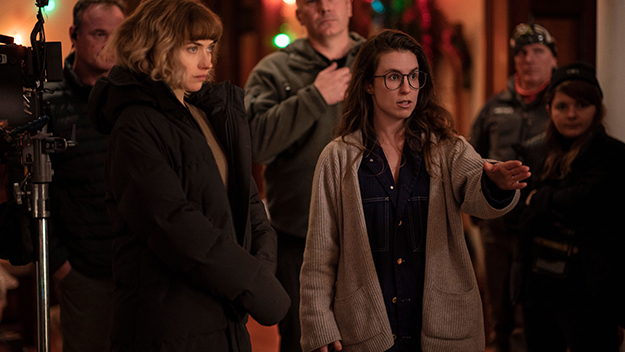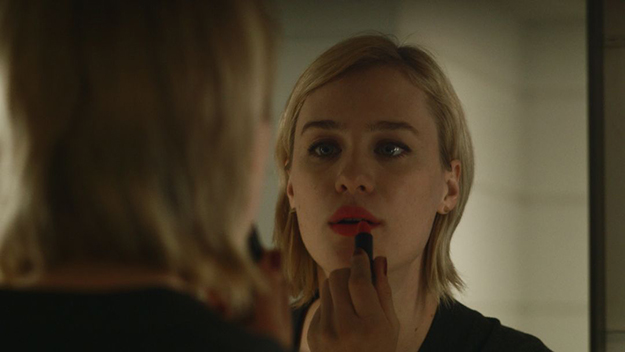Present Tense: Sophia Takal’s Small Moments
Present Tense is a column by Sheila O’Malley that reflects on the intersections of film, literature, art, and culture.

Imogen Poots and director Sophia Takal on the set of Black Christmas (2019)
How dangerous small moments can be. Hopes shatter in a pause that goes on too long. A small smile can stop you in your tracks. You were hoping for a bigger smile. Is something wrong? The sight of a human back can be devastating. It’s turned away from you. A turned back makes you feel needy. Feeling needy is unbearable. On the surface, it may seem that in some of the scenes in Sophia Takal’s first two films nothing much happens. It’s just a conversation at a party, a flirty interaction at a loud bar, a walk in the woods. What’s the big deal? But Takal knows it’s a big deal. Takal feels the tectonic plates shift underneath. Irrevocable things are moving into place. Fates are being decided. At every moment, chaos threatens to rush in, filling the void, a void the characters aren’t even aware is beneath them.
Since Takal’s Black Christmas just opened—a literal horror movie and a remake of the 1974 cult classic—I thought it might be interesting to revisit Takal’s earlier work, two incredibly creepy films called Green (2011) and Always Shine (2016), films where Takal explored the vast scary space where relationships are ominous, over-charged, unbearable. Fighting with your best friend, or having a sexual miscommunication with your boyfriend, is not the end of the world but it feels like the end of the world while it’s happening. This is what Takal is after: what things feel like, the peril in relationships, in bonding, in intimacy, particularly for women. Miscommunication, jealousy, social pressures, create a pressure cooker environment where freedom is impossible. This is mostly the realm of melodrama, not kitchen-sink realism, but it’s also the realm of horror, and both Green and Always Shine read as horror films, although the horror is hard to point to. That’s the problem. That’s also the reality. A monster isn’t in the woods. A killer isn’t on the loose. So why then are the characters so unnerved? Well, because life is tough. Emotions are sometimes ugly. The monster is the characters’ unresolved feelings, the words they are afraid to say.

Green (Sophia Takal, 2011)
Green is just over an hour long, but it’s mood is huge, dark and fraught with peril. In it, Sebastian (Lawrence Michael Levine—who co-produced with Takal) and his girlfriend Genevieve (Kate Lyn Sheil) move to a cabin in the country to spend a year practicing sustainable farming so that Sebastian can write about it on his blog. (Let’s pause a moment to reflect on Takal’s vicious wit.) Their first morning there, Genevieve finds a woman (Takal) asleep in the yard. This is Robin, a friendly and helpful motormouth, who infiltrates Sebastian and Genevieve’s relationship almost overnight. It’s not clear what Robin’s intentions are: does she mean them harm, or is she just a nice person, and Genevieve and Sebastian, cynical New Yorkers, aren’t used to friendly rural people? It could be any or all or none of these things, or it could all just be a figment of Genevieve’s heated imagination. Genevieve at first really likes Robin. However, after she lets Robin into her confidence about some of the problems she’s having with Sebastian, Genevieve starts to disintegrate. Her boundaries blur. She’s haunted by hallucinatory visions. Takal uses dissolves very deliberately, long slow dissolves, so that faces bleed into the landscape and vice versa. Everyone is in the process of dissolving. Nobody can keep their shape, their persona, intact. Genevieve and Robin even look alike. In one scene, the two of them sit at a flea market, and they’re both wearing bright red shirts, long brown hair blowing in the breeze, and they’re practically indistinguishable.
This is an image Takal will explore even more explicitly in Always Shine, written by Levine, and starring Mackenzie Davis and Caitlin FitzGerald. What an overwrought fever dream this film is, with two magnificent performances at the center of it! Two actresses drive to Big Sur for a weekend away. Beth (FitzGerald) has had success in her career, albeit appearing in horror movies, where she’s always the naked girl. Anna (Davis) has had no success, even though she is the better actress (even Beth acknowledges this). But Anna is prickly, volatile, and fragile. She’s “too much.” She’s pushy. And not in a “you go, girl” way. You can see why people would shy away from working with Anna. She is unstable. One of the things Always Shine does so well is capture the uneasiness of feeling competitive with someone who is supposed to be your friend, the pain of having mixed emotions when a friend “pulls ahead” of you. You’re supposed to be happy when good things happen for your friend, but Anna can’t manage it. She tries. But she’s too broken.
Always Shine is a biting critique of the career of young actresses, something Takal knows a lot about, coming to her career as a director from a busy career as an actress, appearing in films as varied as Gabi on the Roof in July, Molly’s Theory of Relativity, All the Light in the Sky, and Wild Canaries. Part of the “mumblecore” crowd, who appear in each other’s movies like a free-wheeling repertory company, Takal brings her knowledge about performance—and about women and performance specifically—to the table in Green and Always Shine. The opening sequence of Always Shine features back to back to-the-camera monologues, one by Beth and one by Anna, and it’s like an acting game for the audience: Is what we’re seeing real, or are they performing? Are they auditions? Or is this real-life? What’s the difference?

Always Shine (Sophia Takal, 2016)
Always Shine is about the disorientation of doubling, and so it’s filled with mirrors, literal and metaphorical. The two women are blonde, with similar body types, and there are shots where Takal plays with the idea that they are interchangeable. It’s certainly how the movie industry sees them: they’re blonde ingenues, a dime a dozen. Eventually, the tension between the women is so unbearable, there’s a confrontation, a chase, a violent scuffle in the darkness. The next morning, Anna wakes up, puts on Beth’s clothes, and goes out into the world. As Beth. Complete with shy submissive manner. She gets what she needs from people when she approaches them the way Beth did. Men like her. The world is a warm place when a woman acts the way Beth does. But it’s not as simple as Anna “assuming” the identity of her friend, or “acting like” her. A dangerous dissolution has taken place. Mulholland-Drive-like, Always Shine goes “through the looking glass” halfway through its run-time, joining the ranks of what critic Miriam Bale has called a “persona swap film.” In her essay about persona swap films, Bale writes, “The recognizable but almost ineffable tone of these films is one in which magical events are accepted in a grounded reality, the above-mentioned dream state, with an ever present, hard-to-shake tinge of nightmarish doubt: ‘Is this real?’ But it isn’t fantasy in opposition to reality; in the worlds of these films there simply is no real.”
Green and Always Shine are terrifying, because at a certain point “there simply is no real.” Genevieve somehow “takes on” Robin’s persona, it seems life or death that she do so, but what is lost in that violent process? A lot. Maybe even everything. Some viewers expressed frustration with Always Shine’s ending (or lack thereof). But to me, it was perfectly clear. It’s a movie about a woman going mad, about a toxic friendship and the dangerous permeability of identity. It’s about a woman’s inability to co-exist with a friend who is also her mirror. Anna loves the mirror, she hates the mirror. She wants to enter its silvery world. Life will be much better over there.

Always Shine (Sophia Takal, 2016)
Sylvia Plath was obsessed with mirrors and with doubles. Her master’s thesis was on the “doubles” in two Dostoevsky novels, The Brothers Karamazov and The Double. Mirrors dominate in her poems and in The Bell Jar, and almost always signify death in her work. In her poem “Mirror,” written from the perspective of the looking glass, Plath writes:
I am important to her. She comes and goes.
Each morning it is her face that replaces the darkness.
In me she has drowned a young girl, and in me an old woman
Rises toward her day after day, like a terrible fish.
The double, the reflection, threatens the real-life identity out in the world. There are two women always, the one in the mirror, and the one outside the mirror. To merge with the mirror means to cease existing. To not merge means a ghostly sense of incompletion, a lack of wholeness.
In one stunning scene in Always Shine, Anna stares at Beth through a clear glass, and Beth’s reflection hovers beside Anna’s devastated face: it is Anna’s double, out there in the world, sapping strength from her, stealing the life that should be hers.
Anna will not be okay. How refreshing.
Sheila O’Malley is a regular film critic for Rogerebert.com and other outlets including The Criterion Collection. Her blog is The Sheila Variations.







